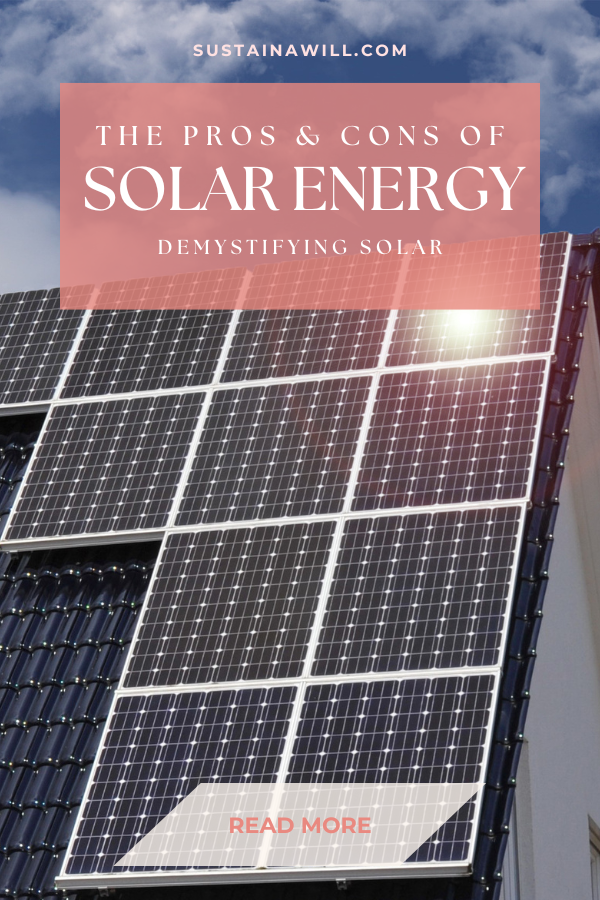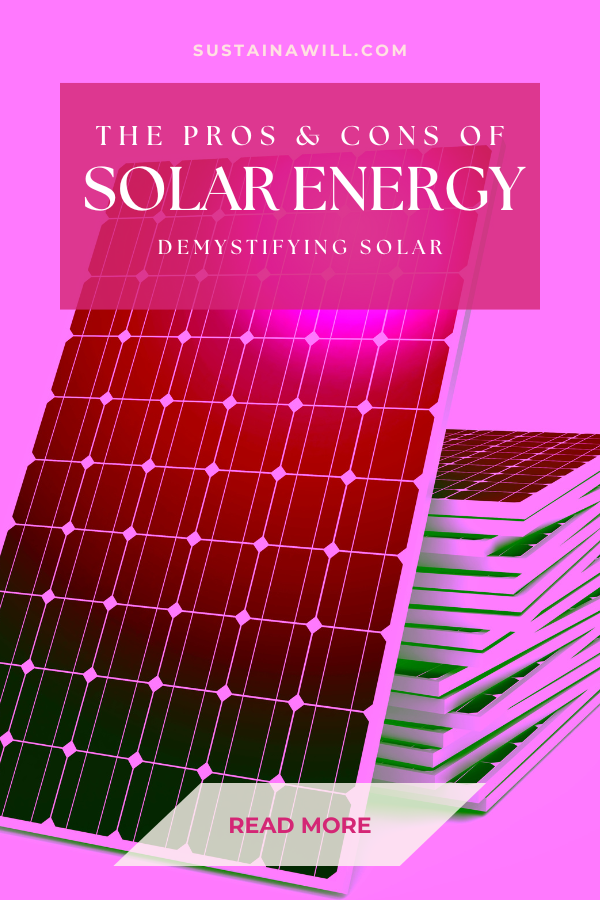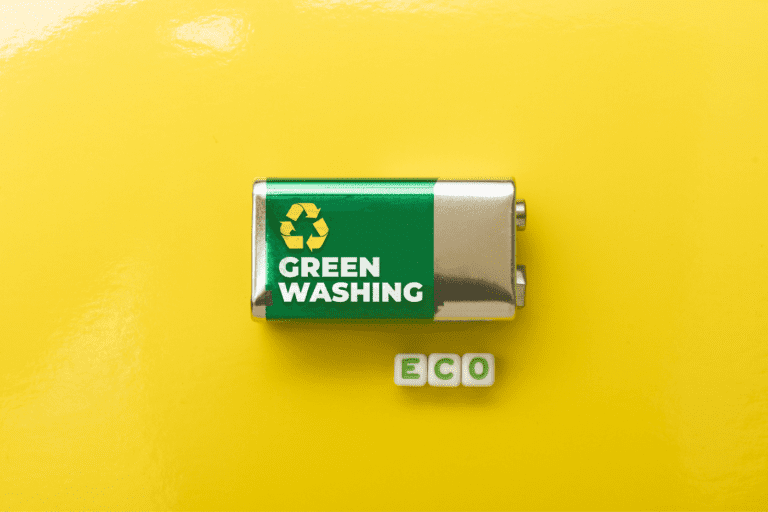Ever wondered if the hype around solar energy holds up to scrutiny? Or maybe you’re pondering whether it’s worth catching those rays for your energy needs? We get it. The solar universe is vast and dazzling.
In this 2024 edition, we’re here to unravel the solar saga—the highs, the lows, and everything in between. Whether you’re eyeing those electric bill savings, craving eco-friendly energy, or just want to ride the solar wave, we’ve got the 411.
Join us as we demystify solar power’s vital pros and cons. Let’s make that sunbeam work for you!🌞
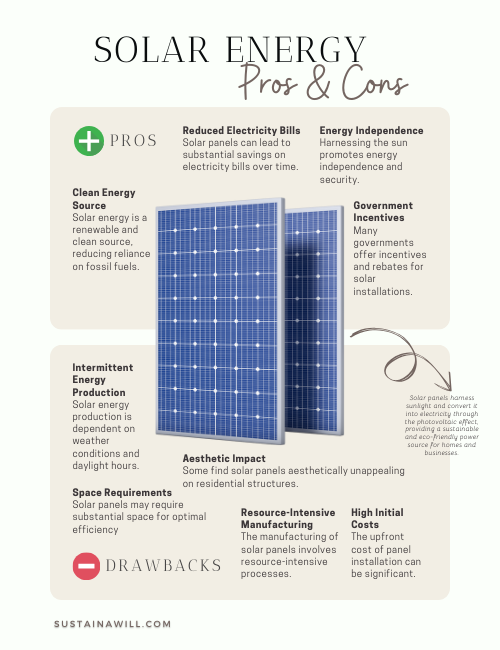
How Solar Energy Works
The following explanation provides a short overview but if you’re interested in the nitty gritty of how solar panels work then check out our post Solar Energy 101: Everything You Need to Know (2024)
1. Sunlight Harvesting
- Our journey commences with solar panels, designed to absorb and convert sunlight into a flow of electrons.
2. DC Generation
- Photons, the particles of sunlight, ”excite” electrons within the solar cells, generating a direct current (DC) – a unidirectional flow of electrical charge.
3. Inverter’s Conversion
- The generated DC electricity, while suitable for some applications, needs transformation for household use. The inverter steps in, converting DC to alternating current (AC), the standard electricity for most homes.
4. Storage for Consistency
- To ensure a consistent power supply, excess energy generated during peak sunlight hours is stored in batteries. This stored energy can then be utilized during periods of reduced sunlight.
5. Integration with the Grid
- The grid acts as a symbiotic partner. Excess solar energy can be fed back into the grid through a process known as net metering, contributing to the overall energy ecosystem.
Armed with newfound solar wisdom, it’s time to take the plunge into the fascinating realm of pros and cons. Ready to weigh the benefits and considerations of solar energy?
The Advantages of Solar Energy
Clean and Renewable Energy Source

- Breathe Easy with Cleaner Energy: Solar power means no smokestacks, no smog—just fresh, clean energy. Enjoy a breath of fresh air as your home is powered by the sun! Solar Energy converts sunlight into electricity through a process that produces zero emissions. No burning of fossil fuels means no harmful pollutants, ensuring the air we breathe remains fresh and clean.
- Sunshine Never Runs Out: The sun is a perpetual powerhouse, radiating an astonishing amount of energy. Each second, the sun generates more energy than humanity has consumed throughout history (yup, really! 4.26 million metric tons per second to be exact). Harnessing this vast energy potential means a practically endless supply of power.
- Tap into Nature’s Endless Battery: The sun, a fusion reactor in the sky, constantly emits energy in the form of sunlight. Solar panels capture this light and convert it into electricity, providing us with a renewable energy source that’s virtually inexhaustible. No need for ‘low battery’ anxiety!
- Nix the Fossil Fuel Dependence: Fossil fuels, our traditional energy sources, are finite and contribute to environmental degradation. Solar energy bypasses this by utilizing the sun’s rays, reducing our reliance on non-renewable resources and promoting sustainable energy production. Say goodbye to digging up the Earth for energy.
- Weather Any Storm, Solar-Style: Solar panels keep the energy coming even during cloudy weather. While direct sunlight is optimal, even diffused light can activate PV cells, allowing you to harness energy even during inclement weather.
Choosing solar isn’t just about flipping a switch—it’s about embracing the wonders of science and harnessing the sun’s incredible potential to fuel a brighter future. 🌞🔬
Cost Savings (Home and RVs)

Slash Your Energy Bills Dramatically
Solar power enables you to generate your own electricity, offsetting the need to purchase it from a utility company. By producing your power, you can significantly reduce your monthly energy bills
Depending on the energy source you are currently using, these are the average pay-off times for solar panels (Type: Monocrystalline) ->
| Energy Source | Average Cost per kWh (USD) | Pay-Off Time (years) |
| House (Electricity) | $0.23 | 6 |
| RV Generator (Natural Gas) | $0.23 | 6 |
| RV Generator (Diesel) | $0.34 | 4 |
| RV Generator (Propane) | $0.45 | 3 |
| RV Generator (Gasoline) | $0.73 | 2 |
Earn Credits Through Net Metering
In many regions, excess solar energy can be fed back into the grid, earning you credits. This process, known as net metering, essentially spins your energy meter backward, leading to lower energy costs or even potential earnings.
Boost Your Property Value
Homes and RVs equipped with solar panels tend to have higher property values. Potential buyers are often attracted to properties with lower operational costs due to solar power.
Secure Energy Costs for the Future
With solar power, you essentially fix a portion of your energy costs for the foreseeable future. After the initial investment, your ‘fuel’ (sunlight) is free, providing a buffer against future energy price hikes.
Financial Incentives

If you’re eager to not only harness the power of the sun but also lighten the financial load, you’re in for a treat. Discover how governments and organizations are paving the way for a greener future while giving your wallet a pleasant boost.🌞💰
1. Federal Solar Investment Tax Credit (ITC)
Description
The federal residential solar energy credit allows taxpayers to claim a percentage of the cost of a solar PV system on their federal income taxes.
Tax Credit Percentage
- Solar PV systems installed in 2020 and 2021: Eligible for a 26% tax credit.
- Solar PV systems installed between 2022-2032: Eligible for a 30% tax credit.
- Solar PV systems installed in 2033: Eligible for a 26% tax credit.
- Solar PV systems installed in 2034: Eligible for a 22% tax credit.
- The tax credit expires starting in 2035 unless renewed by Congress.
2. State-Based Solar Incentives
- Pros: Vary by state and can include rebates, tax credits, performance-based incentives, etc.
- Cons: Availability and amount depend on your location and may have specific requirements.
3. Solar Renewable Energy Certificates (SRECs)
- Pros: Earn credits for the clean energy your system produces, which can be sold for additional income.
- Cons: In some states, RVs might be eligible but availability and value vary by state; not all states have SREC programs.
4. Property Tax Exemption
- Pros: Exempts the added value of your solar system from property tax assessments.
- Cons: In some states, RVs might be eligible but availability and terms vary by location.
5. Sales Tax Exemption
- Pros: Exempts the purchase of solar equipment from sales tax.
- Cons: In some states, RVs might be eligible but availability and terms vary by location.
Environmentally Friendly

- Reduce Your Carbon Footprint: Solar power is a clean, green source of energy that produces no greenhouse gases or air pollutants. By using it, you actively contribute to reducing carbon emissions and fighting climate change.
- Conserve Water Resources: Unlike traditional power generation (particularly those fueled by fossil fuels, which consume vast amounts of water for cooling), solar energy requires minimal to no water usage for daily operations. This is especially crucial in regions facing water scarcity or droughts.
- Mitigate Air and Water Pollution: Solar energy helps combat air and water pollution caused by the burning of fossil fuels. By reducing our reliance on such pollutants, we improve air quality and protect aquatic ecosystems.
- Preserve Natural Habitats and Biodiversity: Utilizing solar energy means we need less land for mining, drilling, and power plants. This helps preserve natural habitats and biodiversity, reducing our overall ecological footprint.
- Combat Climate Change and Global Warming: Solar power is a potent tool in the fight against climate change. By reducing our reliance on fossil fuels, we mitigate global warming and its catastrophic consequences.
Low Maintenance and Long Lifespan

- Low Maintenance Requirements: Solar panels have minimal maintenance needs. Once installed, they require occasional cleaning and routine checks. Solar panels are typically constructed with durable materials, designed to withstand various weather conditions. With no moving parts, there’s less that can go wrong, resulting in reduced maintenance hassles and costs.
- Long Lifespan: Solar panels have a long lifespan, often exceeding 25 years. The photovoltaic cells that make up the panel are made from materials like silicon, known for their stability and durability.
This ensures a stable, long-term energy source for your home or RV, and many panels can continue producing electricity even beyond their expected lifespan. - Resilience and Durability: Solar panels are engineered to withstand hail, snow, high winds, and even minor impacts. Their robust design ensures they can handle the elements, giving you a reliable and resilient power source.
Science Bit: Solar panels undergo rigorous testing for their structural strength and durability. This involves simulating extreme weather conditions to guarantee their ability to endure real-world challenges. - Warranty and Performance Guarantees: Most solar panels come with extensive warranties, often covering 20-25 years. Additionally, performance guarantees assure that your solar system will continue to produce a certain percentage of its original capacity over its lifetime.
Science Bit: Solar panel warranties and guarantees are backed by thorough testing and analysis. Manufacturers have confidence in their product’s ability to maintain performance and durability, ensuring consumers can rely on solar energy for years to come.
Investing in solar energy not only means benefiting from its longevity and ease of upkeep but also contributing to a sustainable future. 🌞🏡🛡️
Energy Independence and Off-Grid Capabilities

- Energy Independence: Imagine the freedom of not being at the mercy of utility companies. Solar energy empowers you to harness the sun’s power, making you less dependent on external factors for your energy needs.
- Off-Grid Capabilities: Solar power grants the ability to live off the grid in remote locations or during power outages. Combining solar panels with energy storage solutions like batteries ensures a consistent power supply even when traditional sources are unavailable.
- Self-Sufficiency and Reliability: Solar power promotes self-sufficiency. By generating your electricity, you become more resilient in the face of emergencies or disruptions to the grid. It’s like having a dependable power companion, ensuring you’re never left in the dark.
- Flexibility and Portability: Solar energy offers the flexibility to set up power sources wherever you need them. Portable solar panels make it easy to charge your devices or power small appliances on the go, enhancing your mobility and adaptability.
Choosing solar energy isn’t just about embracing a sustainable power source; it’s about gaining independence and reliability, ensuring you have the power you need, wherever you are. 🌞⚡🗺️
The Disadvantages of Solar Energy
High Initial Installation Costs

- High Initial Investment: The upfront cost of installing a solar power system can be significant. This includes the cost of solar panels, inverters, batteries (if applicable), installation labor, and other associated equipment. This financial commitment can deter some people from adopting solar energy.
Insightful Info: While the initial investment might be high, think of it as a long-term investment. Over the years, the savings on energy bills often offset the initial expenses, resulting in overall financial gain. - Financing Challenges: Securing financing for solar installations can be challenging for some. Loans, leases, or power purchase agreements may require a good credit score, and the terms of repayment can sometimes be burdensome for certain individuals or households.
Insightful Info: Many regions offer incentives, grants, or low-interest loans to encourage solar adoption, making it crucial to research and capitalize on these opportunities. Additionally, solar companies often provide various financing options to suit different budgets. - Initial Research and Planning: Properly assessing your energy needs, understanding the local regulations, and selecting the right solar system can be time-consuming and demanding in terms of research and planning.
Insightful Info: While it requires effort, the research and planning phase ensures you choose a system that suits your needs, maximizing the return on your investment and minimizing future hassles.
High initial installation costs can indeed present a hurdle, but with the right knowledge and financial planning, solar energy can be a viable and beneficial long-term investment. It’s all about understanding the initial costs in the context of the tremendous savings and benefits that follow. 💡💰🔧
Intermittent Energy Production
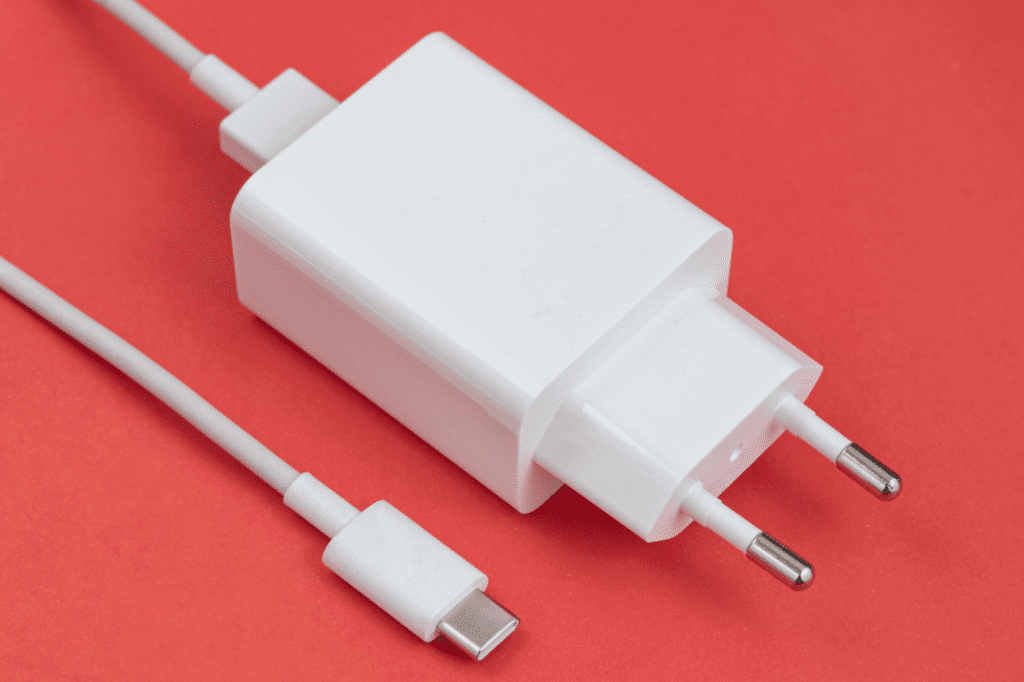
- Weather Dependency: Solar power generation relies on sunlight, making it weather-dependent. Overcast days, rain, or snow can significantly reduce energy production. This intermittency poses a challenge in ensuring a consistent power supply.
Insightful Info: Advanced forecasting technologies can help predict weather patterns, aiding in better planning for intermittent energy production. Additionally, combining solar with energy storage solutions mitigates this issue, ensuring a more reliable power supply. - Day-Night Fluctuations: Solar panels only generate electricity during daylight hours. As a result, there’s a clear fluctuation in energy production, with zero output during the night.
Insightful Info: Energy storage solutions like batteries can store excess energy generated during the day for use at night, making solar a more reliable and consistent energy source 24/7. - Seasonal Variations: The angle and intensity of sunlight vary with the seasons, affecting solar power output. Winter months with fewer daylight hours can particularly impact energy production.
Insightful Info: Planning the solar panel installation considering seasonal changes and optimizing the system for the specific region’s sunlight patterns can help manage this intermittency more effectively. - Geographical Location: Different geographic locations receive varying amounts of sunlight throughout the year. Areas farther from the equator may experience more significant variations in solar power output due to the changing angle of the sun.
Insightful Info: Understanding your geographic location’s solar potential and installing additional panels or optimizing their positions can help counterbalance the intermittency caused by geographical factors.
Intermittent energy production is a challenge inherent to solar power. However, by integrating energy storage solutions, optimizing system configurations, and utilizing weather forecasting technologies, we can significantly mitigate the impact of intermittency and ensure a more reliable and consistent energy supply. 🌞⚡🌧
Space and Aesthetics

- Space Requirements: Solar panels require a significant amount of space for installation, especially if you aim to generate a substantial amount of energy. Not all properties or locations may have sufficient space available for installing an effective solar system.
Insightful Info: Innovations in solar technology, like higher efficiency panels, allow for better energy production in smaller spaces. Additionally, integrating solar into existing structures like roofs, carports, or vertical installations can optimize space usage. - Aesthetic Impact: Solar panels can alter the aesthetic appearance of a building or landscape, which may not align with the preferences or regulations of certain neighborhoods or historical areas. Some may find solar panels visually unappealing.
Insightful Info: Modern solar panels come in various designs and colors, providing more aesthetic options. Integrated solar solutions like solar roof tiles or building-integrated photovoltaics (BIPV) offer a sleeker, more integrated appearance. - Roof Compatibility: The condition, angle, and orientation of a roof play a vital role in the efficiency of a solar panel system. Roofs that are not compatible may require costly modifications or, in some cases, may not support solar installation.
Insightful Info: A professional solar assessment can help determine roof compatibility and identify any necessary modifications. Innovative mounting systems can adapt to various roof types, ensuring effective solar installation. - Land Availability: For ground-mounted solar systems, significant land space is required. This may not be feasible for urban areas or densely populated regions where land is limited or costly.
Insightful Info: Urban areas can leverage rooftop solar installations to overcome land availability challenges. Additionally, community solar projects allow individuals to invest in solar energy generation without the need for land on their property.
Balancing the space requirements and aesthetics of solar panels with efficiency and effectiveness is crucial. With advancements in solar technology, there are now more options to choose from, enabling a better integration of solar power into various spaces while maintaining a pleasing aesthetic appeal. 🌞🏡✨
Energy Storage Challenges

- Battery Costs and Efficiency: The cost of energy storage batteries can be a significant investment, impacting the overall affordability of a solar power system. Additionally, energy losses during charging and discharging processes can affect efficiency.
Insightful Info: Continuous advancements in battery technology are driving prices down and enhancing efficiency. Exploring various battery options and calculating the long-term cost-benefit analysis helps in making informed choices. - Limited Storage Capacity: Batteries have a finite storage capacity, which can be a challenge during extended periods of low sunlight, such as during winter or in regions with extended overcast conditions.
Insightful Info: Properly sizing the battery system according to energy needs and considering grid-tied systems where excess energy can be sent back to the grid for credits helps manage limited storage capacity effectively. - Maintenance and Lifespan: Energy storage systems require regular maintenance, and the batteries have a limited lifespan. Replacing batteries can be an additional cost and may not always align with the solar panel lifespan.
Insightful Info: Opting for reliable battery brands, performing routine maintenance, and considering the total cost of ownership, including replacements, aids in managing long-term maintenance costs. - Environmental Impact: The production, usage, and disposal of batteries can have environmental implications, including resource depletion and potential pollution.
Insightful Info: Sustainable battery disposal practices and advancements in battery recycling technologies are being developed to minimize the environmental impact, promoting responsible energy storage usage.
Addressing energy storage challenges involves striking a balance between efficient energy production, smart energy management, and selecting suitable energy storage solutions.
As technology progresses and more sustainable and cost-effective energy storage options emerge, these challenges are continuously being mitigated, bringing us closer to reliable, round-the-clock solar energy utilization. ☀️🔋💡
Emerging Solar Technologies: What to Expect
- Supercharged Efficiency: Picture solar panels that have become like athletes, converting sunlight into electricity more efficiently than ever! Through cutting-edge materials and manufacturing techniques, solar panels have upped their game, producing more energy from the same amount of sunlight.
Insightful Info: With these efficiency superstars, you get more bang for your buck, making solar an even better choice for energy needs. - Solar Innovation, Thin yet Mighty: Imagine solar panels as thin as a sheet of paper, flexible enough to wrap around objects. That’s the magic of thin-film solar cells! They’re changing the game by being lightweight and adaptable, fitting into various aspects of our lives.
Insightful Info: It’s like having solar power at your fingertips, literally! - Capturing Sun from All Angles: Bifacial solar panels can absorb sunlight not only from above but also from below by reflecting off surfaces. This means more energy and more savings!
Insightful Info: Bifacial panels are the true solar heroes, capturing every ray of sunshine for maximum power. - Perovskite Marvels: Perovskite is a promising material for solar cells due to its high efficiency and potential for low-cost production. Ongoing research aims to enhance stability and longevity for practical applications. They are disrupting the solar scene with their potential to bring solar power to the masses.
Insightful Info: Perovskite solar cells have gained attention for their potential to revolutionize the solar industry, making solar energy more accessible and affordable in every corner of the world! - Energy Storage that Packs a Punch: Energy storage solutions, like advanced batteries, have witnessed substantial advancements. Lithium-ion batteries dominate the market, providing efficient and compact storage for solar-generated power.
Insightful Info: Research into alternative battery technologies, such as solid-state batteries and flow batteries, is ongoing to address efficiency, cost, and sustainability concerns. - Smart Inverters: The Command Center: Think of inverters as the brain of your solar setup. They’re getting smarter and more intuitive, ensuring that the solar power generated is optimized and seamlessly integrated into your life.
Insightful Info: Modern inverters and power management systems enable better control, monitoring, and integration of solar power into the grid. They facilitate real-time adjustments for optimal performance.
As we ride this wave of solar innovation, we’re approaching a future where solar energy isn’t just a sustainable choice; it’s an exciting, efficient, and accessible one too! 🌞⚡
Final Verdict: Solar Panels – Shine On for a Bright Future! ☀️
Picture this: a world where your energy bills shrink, your home value soars, and you’re a bona fide eco-warrior. Sounds good, right? Well, solar panels make this vision a dazzling reality!
Show Me the Money
Yes, there’s an initial cost, but consider it an investment in a money-generating machine. Solar panels slash your electricity bills, leaving more cash in your wallet to splurge on things you love – like vacations or a treat-yourself spa day perhaps!
Future-Proof Your Home
Solar technology is advancing faster than the latest TikTok trends. Investing in solar now means you’re future-proofing your home. Expect more efficiency, sleeker designs, and even more reasons to brag to your neighbors!
In a world where going solar is a no-brainer, don’t just dip your toes, dive in! Solar panels are your ticket to a brighter future, financially and sustainably. So, catch those rays and let your home shine, because solar panels? They’re the real MVPs of the energy game! ☀️🏆
